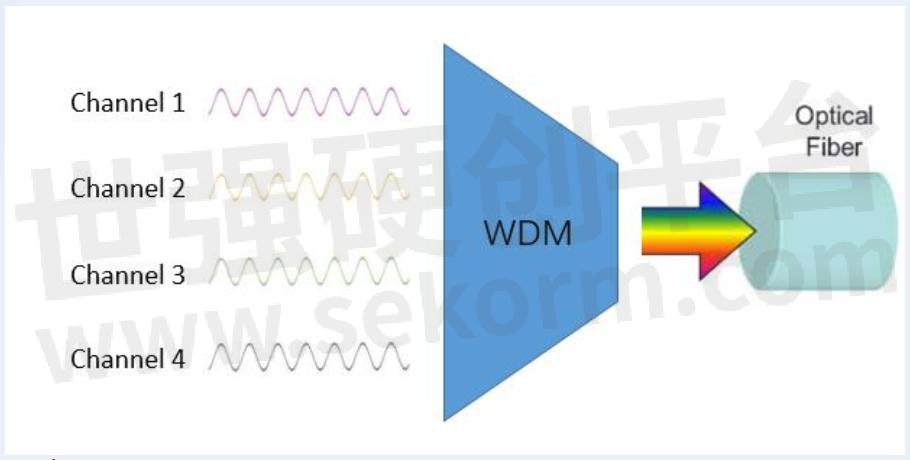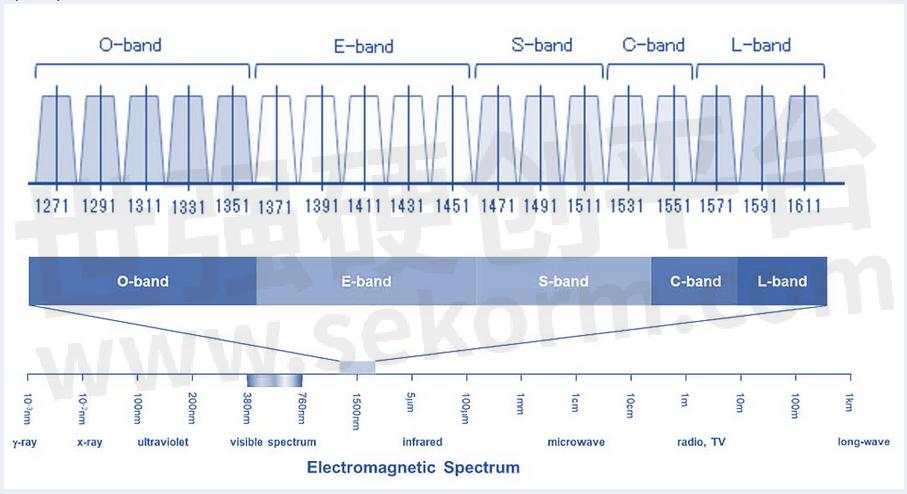What is WDM?

Wavelength Division Multiplexing (WDM) is a technique in fiber optic
transmission for using multiple light wavelengths to send data over the
same medium. Two or more frequencies of light can travel along one
fiber, and multiple signals transmit in an optical waveguide at
different wavelengths.
Fiber-optic transmission systems in the early stage load information to glass fiber with simple light pulses. The "on and off" of the light represents "0" and "1" in the digital world. Basically, from roughly 670nm to 1550nm, the light can be of any wavelength.
Fiber optical communications modems used low-cost LEDs to put near-infrared pulses onto low-cost fiber in the 1980s. The demand for information began to increase afterward, and so did the need for data bandwidth. Early systems delivered 155 Mbps data streams over very long distances with a 1310nm laser solution. However, the capacity was quickly exhausted. Advances in optoelectronic components over the years afterward allowed the design of systems that simultaneously transmitted multiple wavelengths of light over a very single fiber, so as to increase fiber capacity greatly. WDM was then brought to applications. Multiple high-bit-rate data streams of 10Gbps, 40Gbps, 100Gbps, 200Gbps, 400Gbps and more recently 800Gbps, can be multiplexed to a single optical fiber.

Two types of WDM:
Coarse WDM (CWDM): Generally, CWDM is defined by WDM systems with fewer than eight active wavelengths per fiber. CWDM is used for short-reach communications, so it's ok to employ wide-range frequencies with adjacent wavelengths spread far apart. Standardized channel spacing offers room for wavelength drift when lasers' temperature goes up and down during their operation.
Dense WDM (DWDM): DWDM is defined according to frequency. DWDM’s smaller wavelength spacing offers much more channels in a single fiber, while costs more to operate. DWDM is suitable for systems with more than eight active wavelengths over a single fiber.
Vendors have found various techniques for cramming 40, 88, or 96 wavelengths of fixed spacing into the C-band spectrum of fiber with WDM technology. Networks today with high-bandwidth applications and sustained bandwidth growth that are quickly facing capacity exhaustion turn to C+L-band solutions, which develop the L-band spectrum of a fiber to double the fiber capacity.

Optical networks evolve quickly to meet ever-increasing bandwidth demands. To take advantage of these benefits fully requires a flexible-grid line system that accommodates these higher-band channels (800G wavelength for example) that require more than 100GHz.
The next-generation coherent modems are smart and programmable that the modem considers a greater variety of band options, and it allows extremely granular tunability.
Boosted by EDF Amplifiers (EDFAs) and Raman amplification, the reach of these DWDM systems can be extended to thousands of kilometers. Highly precision filters are required to secure a specific wavelength from being interfered with by adjacent wavelengths. Also, DWDM systems must use precision lasers that operate at a constant temperature in order to keep channels on target.
One of the outstanding features of deploying DWDM in a flexible grid photonic system is signal independence. Based on this, many networks previously designed for 10Gbps and 40Gbps are able to carry 200Gbps channels, and many others deployed with flexible grid capability are now carrying 400Gbps and even 800Gbps signals.
T&S offers a wide range of solutions to address customer requirements, from the edge to the core, over a flexible range of platforms.
- +1 Like
- Add to Favorites
Recommend
This document is provided by Sekorm Platform for VIP exclusive service. The copyright is owned by Sekorm. Without authorization, any medias, websites or individual are not allowed to reprint. When authorizing the reprint, the link of www.sekorm.com must be indicated.


























































































































































































































































































































































































































































































































































































































































































































































































































































































































